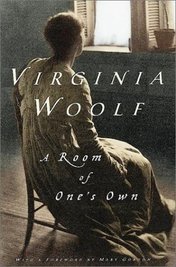
I’ve just started reading A Room of One’s Own (which I hope you knew without me telling you is by Virginia Woolf), and though I’m only a chapter in, I feel the need to blog about it.*
If you haven’t read it (I’m betting most people haven’t, as it’s unencouragingly dense with Woolf’s typical long-winded and tangential style), it’s basically a compilation of Woolf’s thoughts on woman writers of fiction, from what is necessary to be a woman writer (shock of shocks, one needs a room of one’s own) to the various obstacles facing female scholars.
By the end of the first paragraph, I was fairly overwhelmed by the fact that this issue being written about eighty-five years ago is still entirely relevant today—not necessarily to the same extent as Woolf was facing (in the U.S., at least), and certainly not only to the gender-spectrum she’s addressing here, but there were more parallels than I could stomach silently.
Those who have read Woolf will back me up when I say: Her narration has less to do with the action than with the stream-of-consciousness descriptions. ARoOO [1] is no exception. However! There is some sort of movement to the story, and that’s the main thing I’m going to talk about, since there’s a certain fairy tale morality-story structure to it.
If you haven’t read it (I’m betting most people haven’t, as it’s unencouragingly dense with Woolf’s typical long-winded and tangential style), it’s basically a compilation of Woolf’s thoughts on woman writers of fiction, from what is necessary to be a woman writer (shock of shocks, one needs a room of one’s own) to the various obstacles facing female scholars.
By the end of the first paragraph, I was fairly overwhelmed by the fact that this issue being written about eighty-five years ago is still entirely relevant today—not necessarily to the same extent as Woolf was facing (in the U.S., at least), and certainly not only to the gender-spectrum she’s addressing here, but there were more parallels than I could stomach silently.
Those who have read Woolf will back me up when I say: Her narration has less to do with the action than with the stream-of-consciousness descriptions. ARoOO [1] is no exception. However! There is some sort of movement to the story, and that’s the main thing I’m going to talk about, since there’s a certain fairy tale morality-story structure to it.

 RSS Feed
RSS Feed





